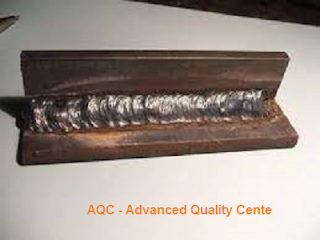Concepts of Welding Defects and Discontinuities

Welding defects can be classified as structural discontinuities and consist of: porosity, slag inclusions, lack of fusion, cracks, etc. Porosity is gas pockets or voids in the weld metal which are free of any solid materials, such as It is formed as a result of gases driven from the weld metal, excessive currents, excessive arc lengths, and improper preparation of the joint. Porosity is generally classified into different groups as follows: scattered, clustered and linear . Scattered porosity occurs throughout the weld metal and the voids may vary in size from microscopic to slightly over 1/8 in.(3 mm). (Figure 6, below); Clustered porosity occurs in groups and may generally be associated with a change in welding conditions. (Figure 7, below); Linear porosity occurs throughout the length of a weld and the voids are in a line with respect to the axis of the weld. This type of porosity generally comes in the root pass and usually can be traced to the inadequate preparation
